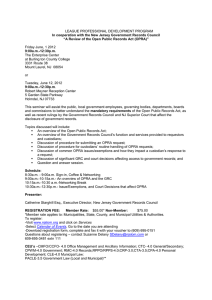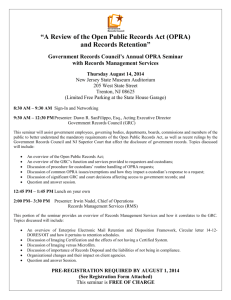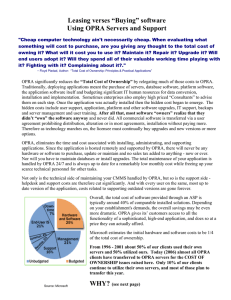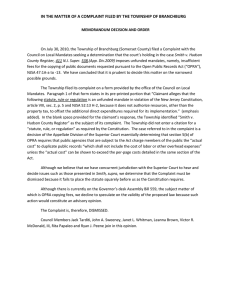Faster FAST: Multicore Acceleration of Streaming Financial Data
advertisement
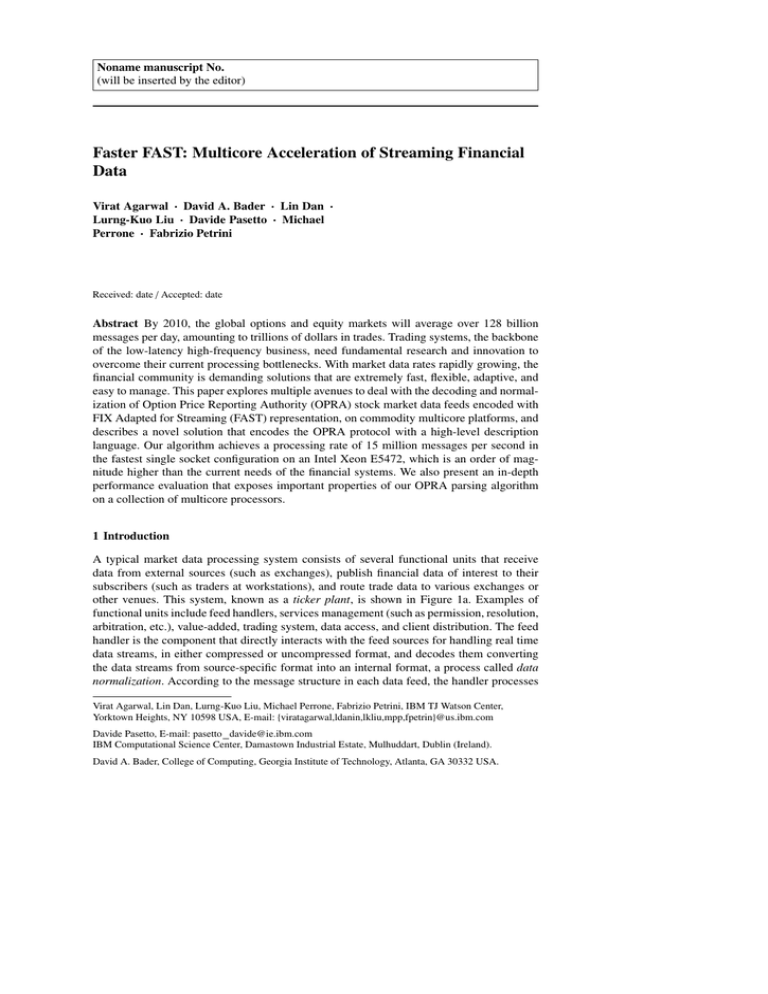
Noname manuscript No.
(will be inserted by the editor)
Faster FAST: Multicore Acceleration of Streaming Financial
Data
Virat Agarwal · David A. Bader · Lin Dan ·
Lurng-Kuo Liu · Davide Pasetto · Michael
Perrone · Fabrizio Petrini
Received: date / Accepted: date
Abstract By 2010, the global options and equity markets will average over 128 billion
messages per day, amounting to trillions of dollars in trades. Trading systems, the backbone
of the low-latency high-frequency business, need fundamental research and innovation to
overcome their current processing bottlenecks. With market data rates rapidly growing, the
financial community is demanding solutions that are extremely fast, flexible, adaptive, and
easy to manage. This paper explores multiple avenues to deal with the decoding and normalization of Option Price Reporting Authority (OPRA) stock market data feeds encoded with
FIX Adapted for Streaming (FAST) representation, on commodity multicore platforms, and
describes a novel solution that encodes the OPRA protocol with a high-level description
language. Our algorithm achieves a processing rate of 15 million messages per second in
the fastest single socket configuration on an Intel Xeon E5472, which is an order of magnitude higher than the current needs of the financial systems. We also present an in-depth
performance evaluation that exposes important properties of our OPRA parsing algorithm
on a collection of multicore processors.
1 Introduction
A typical market data processing system consists of several functional units that receive
data from external sources (such as exchanges), publish financial data of interest to their
subscribers (such as traders at workstations), and route trade data to various exchanges or
other venues. This system, known as a ticker plant, is shown in Figure 1a. Examples of
functional units include feed handlers, services management (such as permission, resolution,
arbitration, etc.), value-added, trading system, data access, and client distribution. The feed
handler is the component that directly interacts with the feed sources for handling real time
data streams, in either compressed or uncompressed format, and decodes them converting
the data streams from source-specific format into an internal format, a process called data
normalization. According to the message structure in each data feed, the handler processes
Virat Agarwal, Lin Dan, Lurng-Kuo Liu, Michael Perrone, Fabrizio Petrini, IBM TJ Watson Center,
Yorktown Heights, NY 10598 USA, E-mail: {viratagarwal,ldanin,lkliu,mpp,fpetrin}@us.ibm.com
Davide Pasetto, E-mail: pasetto davide@ie.ibm.com
IBM Computational Science Center, Damastown Industrial Estate, Mulhuddart, Dublin (Ireland).
David A. Bader, College of Computing, Georgia Institute of Technology, Atlanta, GA 30332 USA.
2
each field value with a specified operation, fills in the missing data with value and state of its
cached records, and maps it to the format used by the system. The ability of a feed handler
to process high volume market data stream with low latency is critical to the success of the
market data processing system, and is the main focus of this paper.
Exchange Feeds
Live Market
Data Feeds
Analytics
Optional
Service
Caching
Low Latency Network
Communication Unicast/Multicast
Remote Office
Distribution
Local Subscribers
1.0
Millions of Messages per Second
Decoding
Normalization
Optional
Service
One Minute Peak Rate
Consolidated
Feeds
0.907
0.9
0.8
0.701
0.7
0.6
0.573
0.5
0.4
0.3
0.2
0.1
0.12
0.15
0.18
0.004 0.007 0.009 0.012 0.025
2000 2001 2002 2003 2004 Dec 05 Jun 06 Dec 06 Jun 07 Jan 08 Jul 08
Fig. 1: (a) High-Level Overview of a Ticker Plant, (b) OPRA market peak data rates
1.1 Skyrocketing Data Rates
The Options Price Reporting Authority (OPRA) is the securities information processor that
disseminates, in real-time on a current and continuous basis, information about transactions
that occurred on the options markets. It receives options transactions generated by participating U.S. exchanges, calculates and identifies the “Best Bid and Best Offer”, consolidates
this information and disseminates it electronically to the financial community. Fueled by the
growth of algorithmic and electronic trading, the global options and equities markets are
expected to produce an average of more than 128 billion messages/day by 2010, rising from
an average of more than 7 billion messages a day in 2007 [12]. In the options market, the
OPRA consolidated feed for all US derivatives business represents a very significant portion
of market data in the national market system. Figure 1b shows that the OPRA market data
rates have dramatically increased over the course of the past 4 years, approaching a peak of
1 million messages per second. The traffic projection for OPRA alone is expected to reach
an average of more than 14 billion messages/day in 2010 [7]. As market data rates continue
to skyrocket, high speed, low latency, and reliable market data processing systems are becoming increasingly critical to the success of the financial institutions both in the U.S. and
abroad.
1.2 High Performance Computing in the Data Center
It is important to note that low latency is critical, especially with the increasing competition
as well as diminishing profit margin. How fast a trading system can respond to the market
will determine who wins and who loses, even a few milliseconds gap in latency is enough to
make the difference. Not surprisingly, many of the technologies that are commonly used in
high performance computing are rapidly appearing in the data centers of many financial institutions [4,3, 1]. Together with the increased performance, data centers are also encountering typical problems in high performance computing: the complexity of developing, testing
and validating parallel software. The need is to reduce power consumption in the processing
units that are often “co-located” near the data feeds to minimize the communication latency
and reduce floor space requirement, which typically comes at a high premium. For these
3
reasons, the financial community is demanding solutions that are extremely fast, easy to
program, and adaptable to dynamically changing requirements.
1.3 Contribution
In this paper we explore several avenues to implement an OPRA FAST decoder and data
normalization on commodity multicore processors. We have first attacked the problem by
optimizing a publicly available version of an OPRA decoder, and based on this preliminary
implementation we have developed two more versions of the decoder, one that has been
written from scratch and hand-optimized for multicore processors and one that uses DotStar [10], a high-level protocol parsing tool that we have recently designed and implemented.
The paper provides four main contributions. (1) The implementation of a high-speed handoptimized OPRA decoder for multicore processors. In the fastest configuration, this decoder
achieves an impressive processing rate of 14.6 (3.4 per thread) millions messages per second with a single Intel Xeon E5472 quad-core socket. (2) A second implementation, based
on the DotStar protocol processing tool is described in Section 4, that is able to capture the
essence of the OPRA structure in a handful of lines of a high-level description language.
This is combined with the same set of building blocks (actions) described above, triggered
by the protocol scanner. The DotStar protocol parser is comparable with the hand-optimized
parser, on average only 7% slower on 5 distinct processor architectures. In the fastest singlesocket configuration, a single Intel Xeon E5472 quad-core is able to achieve a rate of 15
million messages per second. (3) An extensive performance evaluation that exposes important properties of the DotStar OPRA protocol and parser, and analyzes the scalability of
five reference systems, two variants of Intel Xeon, AMD Opteron, the IBM Power6, and the
SUN UltraSPARC T2. (4) Finally, we provide insight onto the behavior of each architecture
trying to explain where the time is spent by analyzing, for all the processor architectures under evaluation, each action associated to DotStar events. All the action profiles are combined
in a cycle-accurate performance model, presented in Section 6, that helps determine the optimality of the approach, and to evaluate the impact of architectural or algorithmic changes
for this type of workload. We believe that this level of accuracy can be useful to both application developers and processor designers to clearly understand how these algorithms map
to specific processor architectures, allowing interesting what-if scenarios.
One evident limitation of this work is that it addresses only a part of the feed handler,
leaving many important questions unanswered. For example, the network and the network
stack are still areas of primary concern. Nevertheless, we believe that the initial results presented in this paper are ground-breaking because they show that it is possible to match or
exceed speeds that are typical of specialized devices, such as FPGAs, using commodity
components and a high-level formalism that allows quick configurability.
2 OPRA feed decoding
OPRA messages are delivered through the national market system with a UDP-based IP
multicast. These messages are divided into 24 data lines or channels (48 when counting
redundant delivery) based on their underlying symbol. Multiple OPRA messages are encapsulated in a block and then inserted in an Ethernet frame. The original definition of an
OPRA message is based on an ASCII format, which uses string based encoding and contains redundant information. With the growth of volume, a more compact representation for
messages was introduced: OPRA FAST (FIX Adapted for STreaming).
4
The techniques used in the FAST protocol include implicit tagging, field encoding, stop
bits, and binary encoding. Implicit tagging eliminates the overhead of field tags transmission. The order of fields in the FAST message is fixed and the meaning of each field can be
determined by its position in the message. The implicit tagging is usually done through the
XML-based FAST template. The presence map (PMAP) is a bit array of variable length at
the beginning of each message where each bit is used to indicate whether its corresponding
field is present. Field encoding defines each field with a specific action, which is specified
in a template file. The final value for a field is the outcome of the action taken for the field.
Actions such as “copy code”, “increment”, and “delta” allow FAST to remove redundancy
from the messages. A stop bit is used for variable-length coding, by using the most significant bit in each byte as a delimiter. This limits the amount of useful information to 7 bits for
every byte of data. FAST uses binary format to represent field values.
S L
O E
H N
OPRA FAST
ENCODED
MESSAGE
L
E
N
OPRA FAST
ENCODED
MESSAGE
-------
E
T
X
S V
O E
H R
SEQ
NUMB
M L
S E
G N
OPRA FAST
ENCODED
MESSAGE
L
E
N
OPRA FAST
ENCODED
MESSAGE
-------
E
T
X
Fig. 2: OPRA FAST encoded packet format. (a) Version 1.03 (b) Version 2.0
Figure 2a shows the format of an encoded OPRA version 1.03 packet. Start of Header
(SOH) and End of Text (ETX) are two control characters that mark the start and end of the
packet. In OPRA FAST version 2.0 (Fig. 2b) there is a header after SOH and before the first
message. The first byte of an encoded message contains the length in bytes and is followed
by the presence map, e.g., presence map 01001010 means field 1, field 4 and field 6 are
present, counting from left. The presence map field is followed by several variable length
integer and string fields that contain the data encapsulated by the message. Data fields that
are not present in an encoded message but that are required by the category have their value
copied from the same field of previous messages and optionally incremented. OPRA data
fields can be unsigned integer or string.
We use the reference OPRA FAST decoder provided along with the standard. This implementation starts by creating a new message, parses the presence map, computes its length
by checking the stop bit of every byte until one is found set, masks the stop bit and copies
all the data into temporary storage. The presence map bits are then examined to determine
which fields are present and which require dictionary values. The implementation proceeds
by checking the category of the message and calls a specific decoder function, which implements the actual decoder for each field in the message. We initially tried to optimize the
reference decoder using a top-down approach, by speeding up the functions that are more
time-consuming. Unfortunately the computational load is distributed across a large number
of functions, and our effort resulted in a very limited performance improvement.
3 A Streamlined Bottom-Up Implementation
We identified primary compute intensive kernels, such as processing variable length encoded presence map (PMAP), integer and string fields, identifying field index, and category
dependent field copy, from the decoding algorithm. We optimize these kernels using various
techniques: unroll to efficiently utilize instruction pipelines, analyze the instructions from
assembly level and minimize average processor cycles consumed per byte of input data.
The reference implementation decodes the input stream by first identifying the category
of the input message and then calls a category specific routine to process subsequent data
fields. This leads to a very branchy code. Our implementation replaces the category-specific
routines by category-specific bitmaps. The number of bits in this bitmap is equal to the total
number of fields contained in the OPRA protocol specification. In the current version of this
5
specification the bitmap can be represented by a 64 bit variable. The index of the bit in the
bitmap specifies the field it represents, and only bits corresponding to fields required by the
category are set. Once the category of the message is determined, this bitmap is passed to the
next building block for specifying the fields that are relevant to a message of this category.
incoming
packets
0x34 0x02 0xA0 0xB8 0x8E J
0011 0100 0000 0010 1010 0000
P 0xBE 0x01 0x08 0xBD 0x88
pos=2
pos=3
pos=6
int
encoded
message
0x34 0x02 0xA0
int
0xB8
str
0x8E
pos=19
pos=15
parse fields
int
J P 0xBE
int
0x01 0x08 0xBD
0x88
PMAP
process
int
process
int
00000001
00001000
00111101
process
str
0000000100010000111101
process
int
decoded
message
56
14
JPM
2
3
6
17461
15
9
12
8
19
17 copy from last
category
of msg
known values
Fig. 3: Presence and field map bit manipulation.
Another optimization is related to processing the PMAP field. The reference code processes this field bit by bit, testing every bit to check if it set or not. However, since a subset
of fields are required for each message category, and given that only a fraction of bits are
typically set in an incoming message, it becomes very inefficient to process each PMAP bit.
We use PMAP to specify the data fields that are contained in the incoming message, that
need to be processed and updated in the decoded format. An xor operation between this
PMAP and the category-specific bitmap gives the fields that are relevant to the incoming
message but are not present. We call this the copy PMAP, that specifies the fields that need
to be copied from last received values.
To determine the next field present in the incoming message we count leading zeroes
(clz) from the PMAP field. This bit (in PMAP) is set to zero after the data field is processed
to enable repetition of the clz operation for subsequent data fields. The clz operation is also
used for the copy PMAP to determine the indexes of the fields that are required to be copied
from previous values. Figure 3 illustrates our optimized decoding algorithm.
We employ another optimization for parsing string fields. To maintain an efficient data
structure we maintain a separate buffer for string values. The strings from the incoming
message are copied into the buffer and the decoded message only contains the offset of
the string from this buffer. This increases the efficiency of the decoding algorithm because,
rather than replicating the entire string, we only store the string offset.
These optimizations create efficient high performance kernels for basic decoding tasks
and increase the elegance of the design. This bottom-up approach eliminates the complex
control flow structure that exists in the reference implementation. In the next section we will
discuss how these kernels can also be integrated into a high level protocol parser.
4 High-Level Protocol Processing with DotStar
A fundamental step in the semantic analysis of network data is to parse the input stream
using a high-level formalism. A large amount of work approached these issues by using
6
declarative languages to describe data layout and transfer protocols. Examples are Interface
Definition Languages (IDL), such as XDR [11], RPC [11], and regular languages and grammars, like BNF, ABNF [8], lex and yacc; or declarative languages like binpac [9]. These
solutions are often tailored for a specific class of protocols, like binary data or text oriented
communication. A common characteristic of all these solutions is that they are very high
level and “elegant”, and provide the user with great expressiveness, but the generated parser
performance is often one order of magnitude slower than an equivalent handcrafted one, and
may be unable to parse real-time heavy-volume applications.
While exploring how to extend our fast keyword scanner automaton to handle regular
expression sets, we developed DotStar [10], a complete tool-chain that builds a Deterministic Finite Automaton (DFA) for recognizing the language of a regular expression set. The
automaton is an extension of the Aho-Corasick [6], the de facto standard for fast keyword
scanning.
A(BC)*D.*EF
BCBC.+EFG
A(BC)*D
EF
BCBC.
EFG
0 0
State
a)
Initial set
After rewrite
b)
d)
E
E
B
A
B
C
F
A
F
Is
1?
Is
1?
C
B
−
B
−
B
G
C
Is
B
G
A
E
B
E
F
B
F
C
Is
1?
G
B
−
−
D
1
1
D
C
C
C
.
−
1
−
D
1
−
1
−
1
B
C
c)
1
−1
1
B
C
Individual DFAs
−
D
B
C
−
−
.
~BD
B
−
B
Combined DFA
Is
1?
D
C
Is
− 1?
1
B
C
− 1?
−
D
Final DFA
Fig. 4: A graphical representation of DotStar compiler steps: a) is the pre-processor, which reduces the number of states, step b) builds individual automata for each regular expression, c) combines them in a unique
automaton and d) computes the failure function.
Finding every instance of a regular expression pattern, including overlaps, is a “complex” problem both in space and time [5]. Matching a complete set of regular expressions
adds another level of complexity: DotStar employs a novel mechanism for combining several regular expressions into a single engine while keeping the complexity of the problem
under control. DotStar is based on a sophisticated compile time analysis of the input set of
regular expression and on a large number of automatic transformations and optimizing algorithms. The compilation process proceeds through several stages (see Figure 4): at first simplifies each regular expression in a normal form, rewrites it and splits it into sub-expressions
and transforms into a Glushkov [2] Non-deterministic Finite Automaton (NFA) and then
turns it into a DFA, These automata are combined together by an algorithm that operates
on their topology. The resulting graph is extended, as in the Aho-Corasick algorithm, by a
“failure” function, that can further modify the graph structure. The result is a single pass
DFA that: (1) groups all regular expression in a single automaton, (2) reports all matches,
including every overlapping pattern, and (3) it is as memory efficient as an NFA.
We defined a simple declarative language, called DSParser, that describes a data layout as a sequence of regular expression fragments “connected” using standard imperative
constructs, like if/then/else/while. Actions can be inserted after a (partial) expression is recognized; these actions are either system actions, that perform common operations or user defined functions on blocks of input data. A precompiler tool parses the declarative language
and builds a suitable regular expression set that is compiled using the DotStar toolchain.
7
A small number of states of the resulting automaton is then annotated with the system and
user defined actions specified in the initial protocol definition. The DSParser source code for
analyzing OPRA version 2.0 messages is remarkably simple, compact and easy to manage:1
MATCH “..........................................”
MATCH “\x01\x02”
PUSH
MATCH “..........”
EXECUTE sequence number
MATCH “...”
LOOP
WHILECNT “.”
PUSH
MATCH “[\x00-\x7f]*[\x80-\xff]”
EXECUTE action pmap
PUSH
(contd ...)
WSWITCH
CASE “[\x80-\xff]”
EXECUTE action field
PUSH
ENDCASE
CASE “[\x00-\x7f]”
MATCH “[\x00-\x7f]*[\x80-\xff]”
SEND 0x02 0
EXECUTE action field
ENDCASE
ENDWSWITCH
ENDWHILECNT
ENDLOOP
Intuitively the resulting automaton will start by skipping the IP/UDP headers and will
match the OPRA version 2.0 start byte and version number. It will then mark the stream
position for the successive action and recognize the initial sequence number for the packet,
calling the appropriate user defined code; after that, it will loop and examine every message
in the packet to detect first the PMAP and then all individual fields.
User defined actions operate on blocks of input data recognized by the parser and the
overall system processing model proceeds along the following steps: (1) look for a section of
data –the automaton reads input symbols and switches state until a PUSH action is reached;
(2) save the start of data: the current stream position is saved in state machine memory; (3)
look for the end of a data field –the automaton reads more input symbols until a state with
a user defined action is found; (4) handle the data field –the user defined action is invoked
over the block of data from the saved position to the current position.
5 Experimental Results
For performance analysis, we assume that each channel (total 24) can inject messages at full
speed by storing the OPRA feeds in main memory, and therefore is not the bottleneck of the
decoder. OPRA packets are 400 bytes on average, each containing multiple messages that
are encoded using the FAST representation. The messages are typically distributed across
the 10-50 byte range, with an average message size of 21 bytes. Thus, each packet contains
19 messages on average. Under the assumption of full injection, we observe that the feeds
across the various channels have very similar data pattern and distribution and they tend to
have the similar processing rate. Since, the performance is insensitive to the OPRA protocol
version, we will consider only OPRA version 2.0 traces in the rest of this paper.
In this section, we present an extensive performance analysis of our algorithm on a variety of multicore architectures. In our tests, we use Intel Xeon Q6600 (Quad), Intel Xeon
5472 (Quad, a.k.a. Harpertown), AMD Opteron 2352 (Quad), IBM Power 6, and Sun UltraSparc T2 (a.k.a. Niagara-2). Power6 and Niagara-2 are hardware multithreaded with 2
threads and 8 threads per core, respectively. Table 1 gives more information about the speeds
and feeds of each architecture. We first discuss the performance of the three approaches
for processing OPRA FAST messages, the top-down reference implementation, the handoptimized bottom-up version and DotStar as discussed in sections 2, 3 and 4, respectively.
Figure 5a gives the decoding rate per thread in millions of messages per second. We observe
1
It is worth noting that the full OPRA FAST protocol is described in a 105-page manual!!
8
that our bottom-up and DotStar implementations are consistently 3 to 4 times faster than the
reference implementation; the Intel Xeon E5472 gives the maximum processing rate for a
given thread, and that our optimized Bottom-Up and DotStar implementations are similar in
terms of performance, with the hand-optimized version that is only 7% faster, on average.
The Sun UltraSparc T2 processor is designed to operate with multiple threads per core, thus
the single thread performance is much lower than other processors. It is also important to
note that our single core OPRA decoding rate is much higher than the current needs of the
market, as shown in Figure 1b.
Performance Comparison
Scalability
4
Top-Down
Bottom-Up
DotStar
3.5
3
Millions of Messages per Second
Millions of Messages Per Second
28
2.5
2
1.5
1
0.5
0
Xeon Q6600
Xeon E5472
Opteron 2352
UltraSPARC T2
Power6
24
20
E
Q
O
P
U
E Xeon E5472
Q Xeon Q6600
O Opteron 2352
P Power6
U UltraSPARC T2
P
16
E
12
8
4E
Q
O
P
0U
1
P
Q
O
P
E
Q
O
P
U
U
U
U
4
U
2
U
8
16
32
64
Threads
Fig. 5: (a) Performance Comparison, (b) Speedup
INTEL Xeon Q6600
INTEL Xeon E5472
AMD Opteron 2352
Sun UltraSPARC T2
IBM Power6
CPU Speed
(GHz)
Sockets
Cores
/Socket
Threads
/Core
Threads
Cache Size
(KB)
2.4
3.0
2.1
1.2
4.7
1
1
1
1
4
4
4
4
8
2
1
1
1
8
2
4
4
4
64
16
4096
6144
512
4096
4096
Table 1
Figure 5b presents a scalability study of our high-level DotStar implementation. In these
tests the threads operate in parallel on different parts of the data from the same OPRA channel. For the Intel Xeon processors our implementation scales almost linearly and processes
15 million messages per second, on a single E5472 quad-core socket and 12 million messages per second, on the Q6600. On Niagara-2, the performance scales linearly up to 16
threads, and reaches 6.8 million messages per second using 64 threads (8 threads/8 cores).
For the IBM Power6, we get a scaling advantage up to 16 threads using 8 cores, giving
a performance of 26 million messages per second. The performance scales linearly up to
8 threads (1 thread per core), with a performance improvement of 1.5x on 16 threads (2
threads per core).
6 Discussion
In this section we provide detailed insight into the performance results presented in the
previous section. The OPRA FAST decoding algorithm can be broken down into 5 main
components, processing of the (1) PMAP field, (2) integer fields, (3) string fields, (4) copying previous values, (5) computing index of fields using clz. Every OPRA message contains
on an average one PMAP field of 5 bytes, integer fields occupying in total 13 bytes, string
fields of 4 bytes, in total 22 bytes.
62.6
22.1
13.6
2.7
0.0
0.0
0.0
0.0
8.1
87.1
4.8
0.0
0.0
1
2
3
4
5
1
2
3
4
5
6
7
8
INT
PMAP
Basic blocks peak
Actions only
Dotstar rate only
Optimal
Actions w/Dotstar
Optimality ratio
Dcopy/msg
Scopy/byte
CLZ/field
%
size
3.6
4.8
8.1
13.3
-
ns
/b
msgs
M/s
11.8
8.8
5.8
3.5
3.1
0.89
11.0
1.4
2.8
2.6
2.5
2.5
2.4
2.4
2.3
2.3
2.3
1.4
1.3
1.4
1.5
1.5
6
7.0
6.0
5.7
5.5
5.4
5.3
5.2
5.1
3.0
3.5
3.7
3.7
3.8
8.5
11.5
19.4
32.0
-
cyc
/b
26.4
3.4
6.7
6.3
6.0
6.0
5.9
5.8
5.6
5.5
5.5
3.4
3.2
3.4
3.6
3.8
INTEL
Xeon Q6600
instr
ns
cyc
11.8
9.5
7.5
4.2
3.8
0.91
msgs
M/s
5
7.0
6.0
5.7
5.5
5.4
5.3
5.2
5.1
3.0
3.5
3.7
3.7
3.8
10.6
20.6
30.0
51.7
-
cyc
/b
45.0
5.7
6
9.9
9.0
8.5
8.3
8.1
8.0
7.8
7.7
4.5
4.9
5.2
5.4
5.5
4.7
4.3
5.7
2.5
2.4
0.96
msgs
M/s
5
7.0
6.0
5.7
5.5
5.4
5.3
5.2
5.1
3.0
3.5
3.7
3.7
3.8
9.0
9.7
7.5
17.5
-
ns
/b
45.1
4.5
4.1
9.4
8.0
7.6
7.4
7.3
7.1
7.0
6.9
4.0
4.8
5.0
5.1
5.1
19.0
20.3
15.7
36.8
-
cyc
/b
94.7
9.5
8.5
19.7
16.9
15.9
15.5
15.4
15.0
14.7
14.4
8.4
10.1
10.5
10.7
10.8
AMD
Opteron 2352
instr
ns
cyc
Table 2: Optimality analysis
3.5
4.4
6.4
11.0
-
ns
/b
15.0
1.9
2.0
3.3
3.0
2.8
2.8
2.7
2.7
2.6
2.6
1.5
1.6
1.7
1.8
1.8
INTEL
Xeon E5472
instr
ns
cyc
0.7
0.6
0.4
0.24
0.2
0.84
msgs
M/s
17
8.0
7.4
7.3
7.5
7.2
7.7
7.9
7.5
3.0
3.0
3.0
3.0
3.0
59.0
69.3
109.8
200.0
-
ns
/b
706.0
15.2
36.9
17.3
16.5
16.0
16.9
15.9
17.5
18.2
16.9
6.5
6.8
5.4
6.6
6.6
70.8
83.2
131.8
240.0
-
cyc
/b
847.2
18.2
44.3
20.7
19.8
19.2
20.3
19.1
21.0
21.8
20.3
7.8
8.2
6.5
7.9
7.9
SUN
UltraSPARC T2
instr
ns
cyc
7.5
5.3
4.1
2.3
2.1
0.92
msgs
M/s
6
7
6.5
6.3
6.2
6.2
6.0
6
6
4
3.5
3.3
3.2
3.2
instr
5.6
7.9
11.2
20.0
-
ns
/b
14.0
3.9
4
4.4
4.2
4.1
3.9
3.9
3.8
3.8
3.9
2.3
2.2
2.0
1.9
1.9
IBM
Power6
ns
26.2
37.2
52.6
94.0
-
cyc
/b
65.8
18.6
18.8
20.7
19.7
19.0
18.6
18.1
17.8
17.9
18.1
10.8
10.3
9.4
8.9
8.8
cyc
9
10
Decoding a message requires copying the last known values into a new data structure,
as the encoded message only contains information on a subset of fields. To find the index of
each new data fields, we perform a clz (count leading zeroes) operation. For each of these
actions we calculate the instructions from assembly level, Table 2 gives the instructions per
byte for processing the PMAP, integer and string fields, on each multicore processor. For
nsec and cycles per byte we compute actual performance, by performing multiple iterations
of the algorithm with and without the corresponding action and normalizing the difference.
Similarly, for the clz action, we compute cycles, nsec, and instructions per data field, and for
the copy msg we compute average nsec and cycles/message.
Using the field length distributions, their occurrence probability rates, and individual
action performance, we compute the aggregate estimated peak performance in the first row
of the last block in the table. Note that this peak estimate does not take into account any
control flow or I/O time. In the second row we give the actual actions-only performance
that is computed by taking the difference between the total performance and performance
after commenting out the actions, lets call it A. The DotStar rate is the peak performance
of our parsing algorithm on OPRA feeds, that does not include any actions on the recognized data fields, lets call it B. We notice that: The optimal row in that block is the estimated
peak performance that we should have got by combining the DotStar routine and our optimized kernels, that is computed using the formula ( A1 + B1 )−1 . We compare this to our actual
performance and compute the optimality ratio in the last row of the table. We observe the
following.
– On the IBM Power6, we get similar nsec/byte performance as compared to Intel Xeon
processor. We believe that our code is not able to take advantage of the deep pipeline
and in-order execution model of the Power6.
– To get maximum performance for the copy msg routine, we developed our own vectorized memory copy using SSE intrinsics, and pipelined load and stores to obtain best
performance. On the Sun Niagara-2 we used a manual copy, at the granularity of an
integer, and unrolled the load and store instructions. With vectorized memory copy we
get about 2x performance advantage over the memcpy library routine, whereas for the
manual scalar copy we get an advantage of 1.2x on Sun Niagara-2.
– On Sun-Niagara, the copy action is much slower than on other processors.
– Our implementation requires integer/string processing as opposed to floating point computation, this fails to utilize the much improved floating point units on Sun Niagara-2.
– On Intel Q6600, cycles/byte performance matches closely with instructions/byte count.
– Our implementation is close to the optimal performance obtained with the high-level
approach, with an average optimality ratio of 0.9.
– Table 3 gives the latency for decoding/processing an OPRA message on each of the
multicore processors discussed in the papers. We decode one message at a time on a
single processing thread, thus the average latency to process a message is given by taking
the inverse of the processing rate. We observe a latency between 200 and 500 nsec on
the Intel/IBM/AMD processors, which accounts for only a negligible latency inside the
ticker plant, under a very high throughput.
7 Conclusions
The increasing rate of market data traffic is posing a very serious challenge to the financial
industry and to the current capacity of trading systems worldwide. This requires solutions
that protect the inherent nature of the business model, i.e., providing low processing latency with ever increasing capacity requirements. We presented a novel solution for OPRA
11
Latency/msg (nsec)
INTEL
Xeon Q6600
INTEL
Xeon E5472
AMD
Opteron 2352
Sun
UltraSparc T2
IBM
Power6
317
261
409
4545
476
Table 3
FAST feed decoding and normalization, on commodity multicore processors. Our approach
captures the essence of OPRA protocol specification in a handful of lines of DSParser, the
high-level descriptive language that is the programming interface of the DotStar protocol
parser, thus providing a solution that is high-performance, yet flexible and adaptive. We
showed impressive processing rates of 15 million messages per second on the fastest single
socket Intel Xeon, and over 24 million messages per second using the IBM Power6 on a
server with 4 sockets. We presented an extensive performance evaluation to understand the
intricacies of the decoding algorithm, and exposed many distinct features of the multicore
processors, that can be used to estimate performance. In the future, we plan to extend our
approach to other components of the ticket plant, and evaluate a threaded-model in DotStar,
to help pipeline independent analytics processing kernels seamlessly.
References
1. Virat Agarwal, Lurng-Kuo Liu, and David Bader. Financial Modeling on the Cell Broadband Engine.
IEEE International Symposium on Parallel and Distributed Processing (IPDPS), pages 1–12, April 2008.
2. V.M. Glushkov. The abstract theory of automata. Russian Mathematical Survey. v16. 1-53.
3. Mike Kistler, Michael Perrone, and Fabrizio Petrini. Cell Processor Interconnection Network: Built for
Speed. IEEE Micro, 25(3), May/June 2006.
4. Dinesh Manocha. General-Purpose Computations Using Graphics Procecssors. IEEE Computer,
38(8):85–88, Aug. 2005.
5. Wim Martens, Frank Neven, and Thomas Schwentick. Complexity of Decision Problems for Simple
Regular Expressions. In MFCS, pages 889–900, 2004.
6. Gonzalo Navarro and Mathieu Raffinot. Flexible Pattern Matching in Strings: Practical On-Line Search
Algorithms for Texts and Biological Sequences. Cambridge University Press, New York, NY, USA, 2002.
7. OPRA. Option Price Reporting Authority. Available at http://www.opradata.com/.
8. P. Overell. Augmented BNF for Syntax Specifications: ABNF, 1997.
9. Ruoming Pang, Vern Paxson, Robin Sommer, and Larry Peterson. binpac: A yacc for Writing Application Protocol Parsers. In IMC’06: Proceedings of the 6th ACM SIGCOMM Conference on Internet
Measurement, pages 289–300, New York, NY, USA, 2006. ACM.
10. Davide Pasetto and Fabrizio Petrini. DotStar: Breaking the Scalability and Performance Barriers in
Regular Expression Set Matching. Technical report, IBM T.J. Watson, 2009.
11. Srinivasan R. RPC: Remote Procedure Call Protocol Specification Version 2, 1995.
12. TABB Group. Trading At Light Speed: Analyzing Low Latency Data Market Data Infrastructure. Available at http://www.tabbgroup.com/, 2007.
